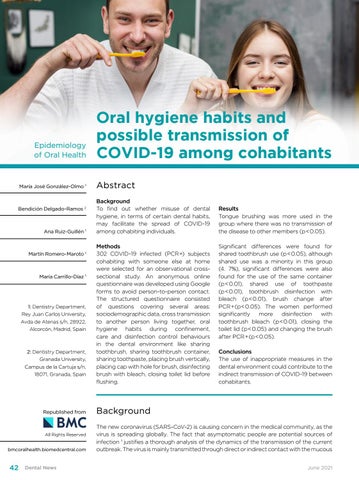Epidemiology of Oral Health
María José González-Olmo 1
Bendición Delgado-Ramos 2
Ana Ruiz-Guillén 1
Martín Romero-Maroto 1
María Carrillo-Díaz 1
1: Dentistry Department, Rey Juan Carlos University, Avda de Atenas s/n, 28922, Alcorcón, Madrid, Spain
2: Dentistry Department, Granada University, Campus de la Cartuja s/n, 18071, Granada, Spain
Republished from
All Rights Reserved
bmcoralhealth.biomedcentral.com
42
Dental News
Oral hygiene habits and possible transmission of COVID-19 among cohabitants Abstract Background To find out whether misuse of dental hygiene, in terms of certain dental habits, may facilitate the spread of COVID-19 among cohabiting individuals. Methods 302 COVID-19 infected (PCR +) subjects cohabiting with someone else at home were selected for an observational crosssectional study. An anonymous online questionnaire was developed using Google forms to avoid person-to-person contact. The structured questionnaire consisted of questions covering several areas: sociodemographic data, cross transmission to another person living together, oral hygiene habits during confinement, care and disinfection control behaviours in the dental environment like sharing toothbrush, sharing toothbrush container, sharing toothpaste, placing brush vertically, placing cap with hole for brush, disinfecting brush with bleach, closing toilet lid before flushing.
Results Tongue brushing was more used in the group where there was no transmission of the disease to other members (p < 0.05). Significant differences were found for shared toothbrush use (p < 0.05), although shared use was a minority in this group (4. 7%), significant differences were also found for the use of the same container (p < 0.01), shared use of toothpaste (p < 0.01), toothbrush disinfection with bleach (p < 0.01), brush change after PCR + (p < 0.05). The women performed significantly more disinfection with toothbrush bleach (p < 0.01), closing the toilet lid (p < 0.05) and changing the brush after PCR + (p < 0.05). Conclusions The use of inappropriate measures in the dental environment could contribute to the indirect transmission of COVID-19 between cohabitants.
Background The new coronavirus (SARS-CoV-2) is causing concern in the medical community, as the virus is spreading globally. The fact that asymptomatic people are potential sources of infection 1 justifies a thorough analysis of the dynamics of the transmission of the current outbreak. The virus is mainly transmitted through direct or indirect contact with the mucous June 2021
